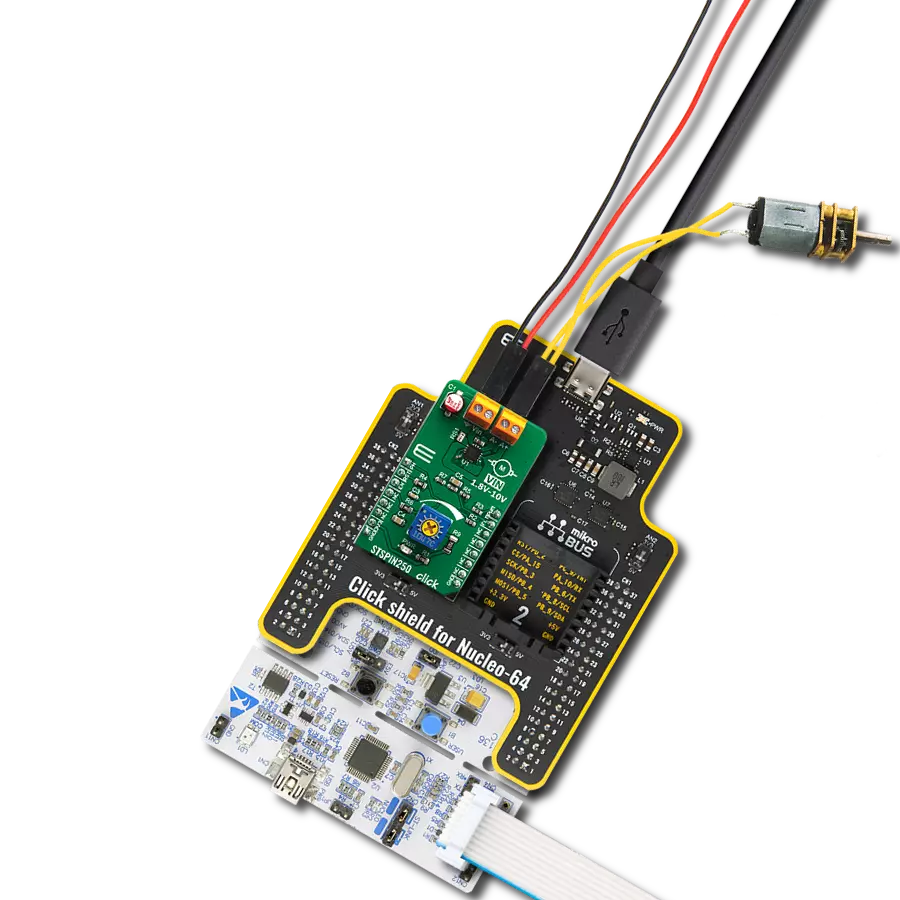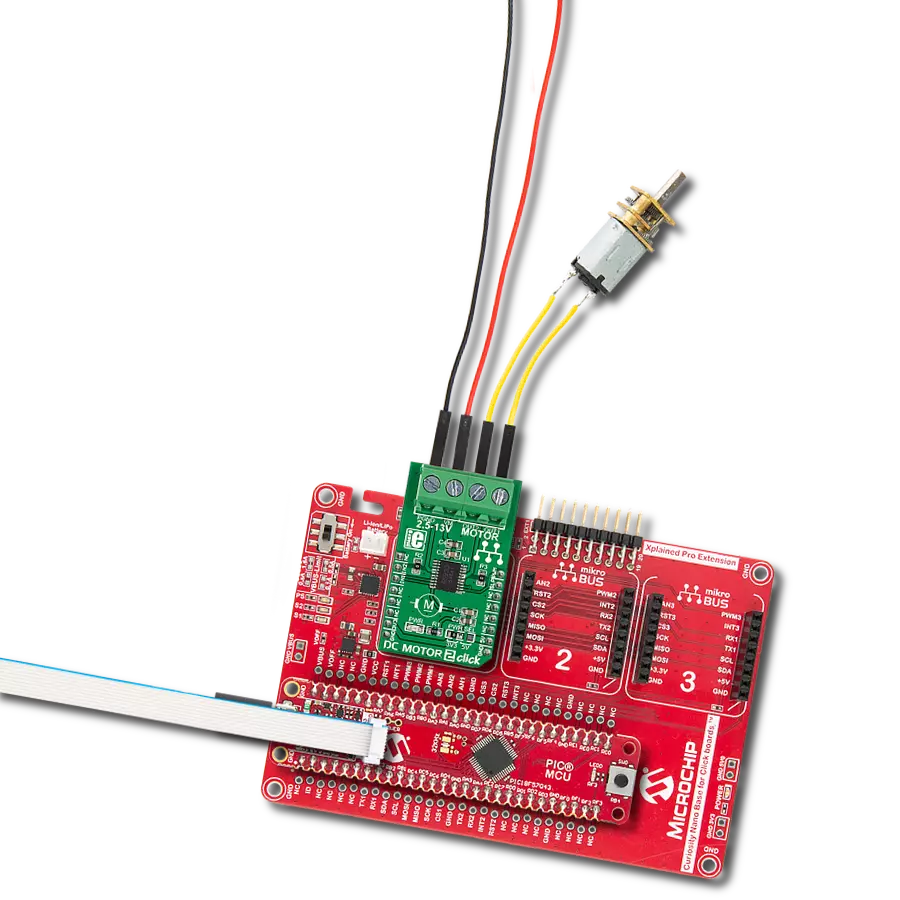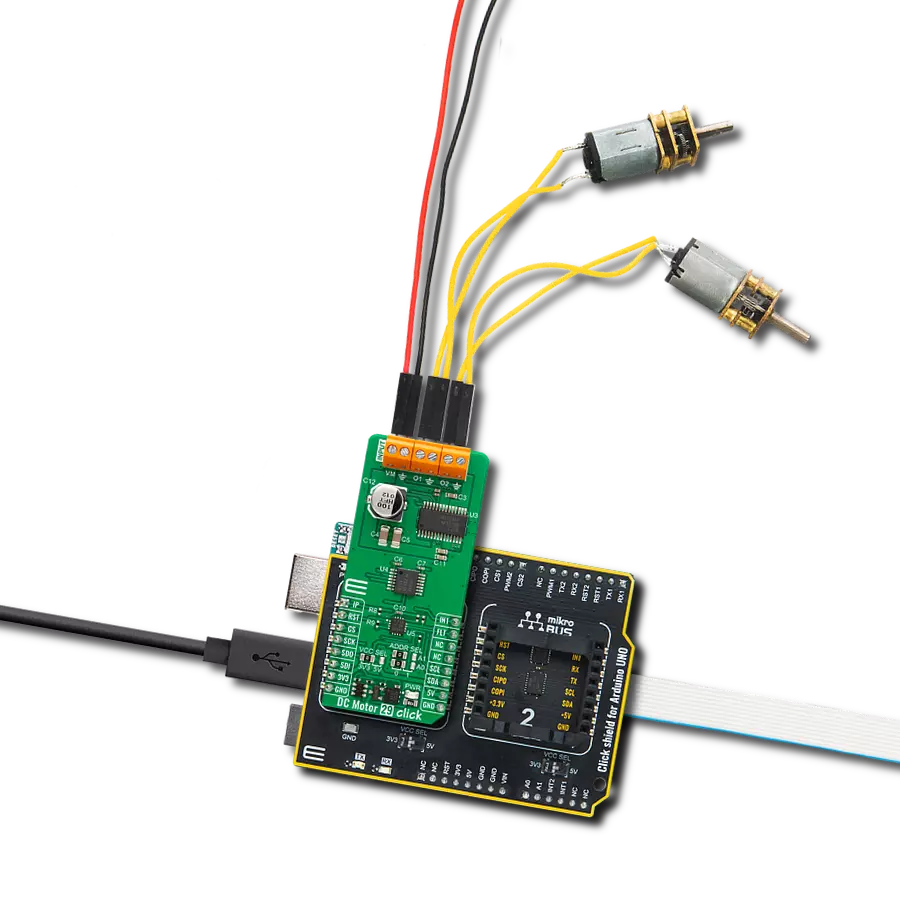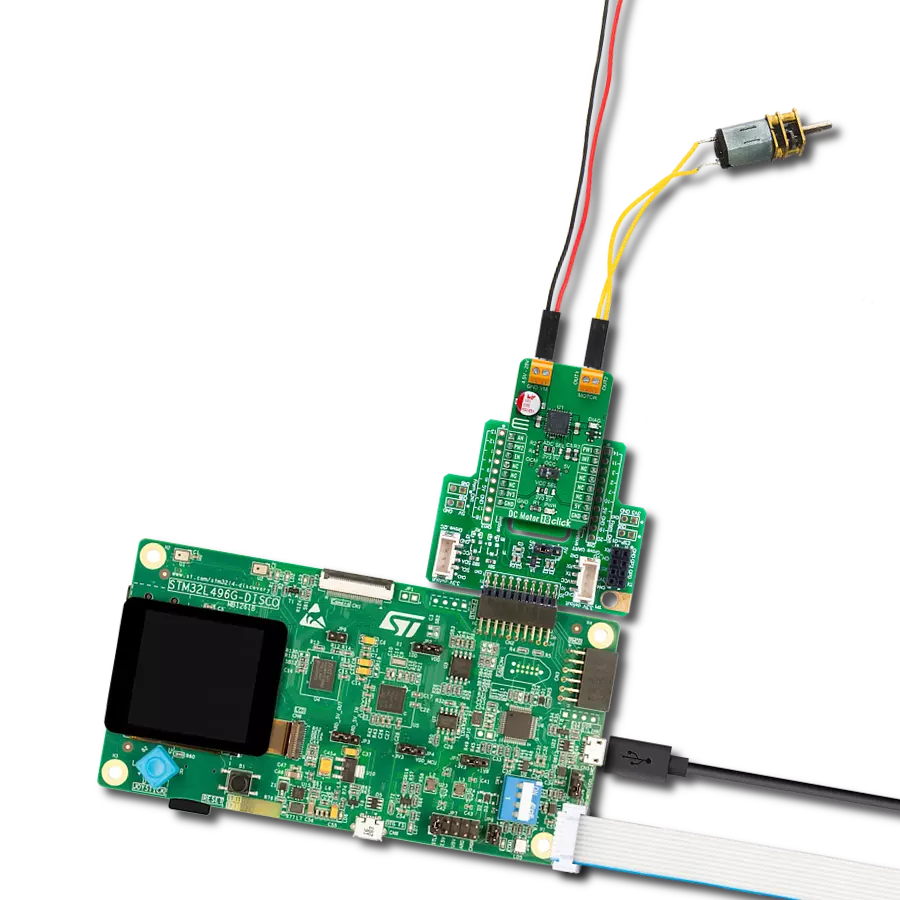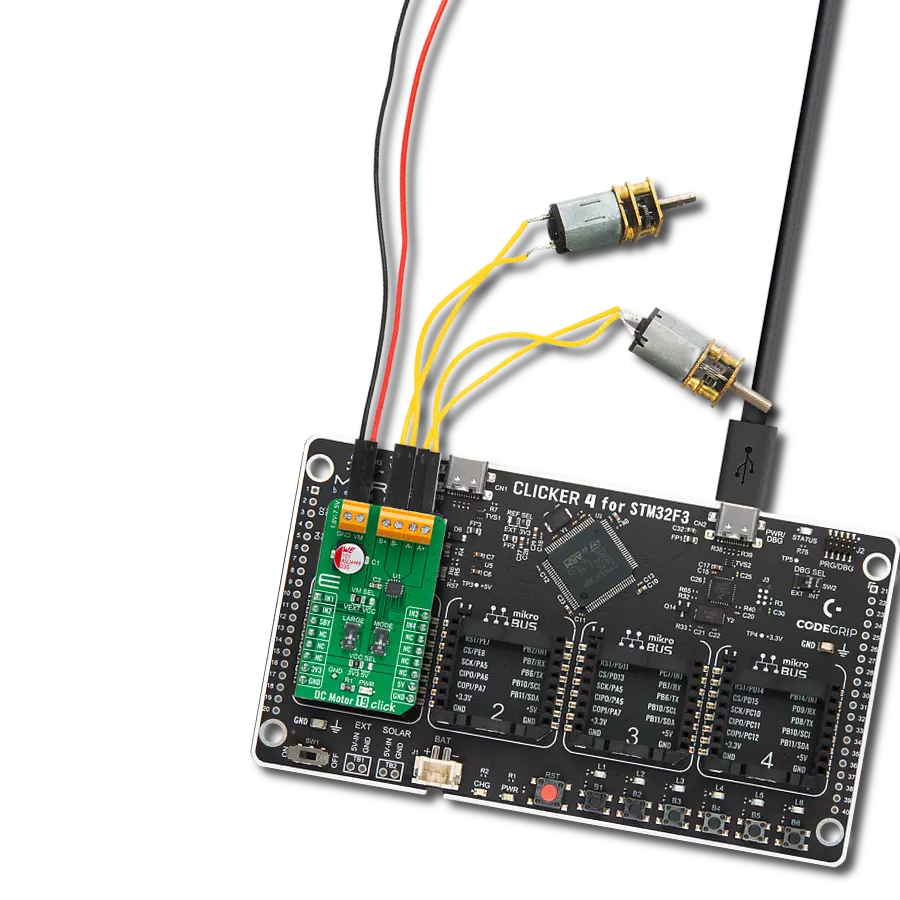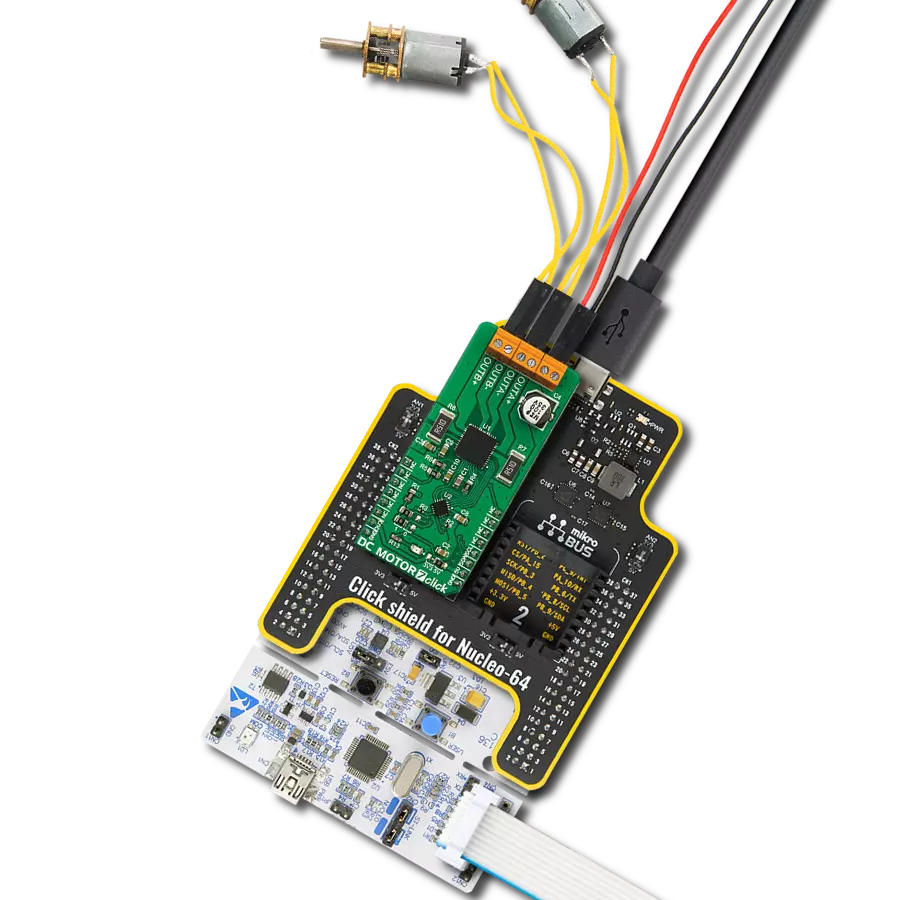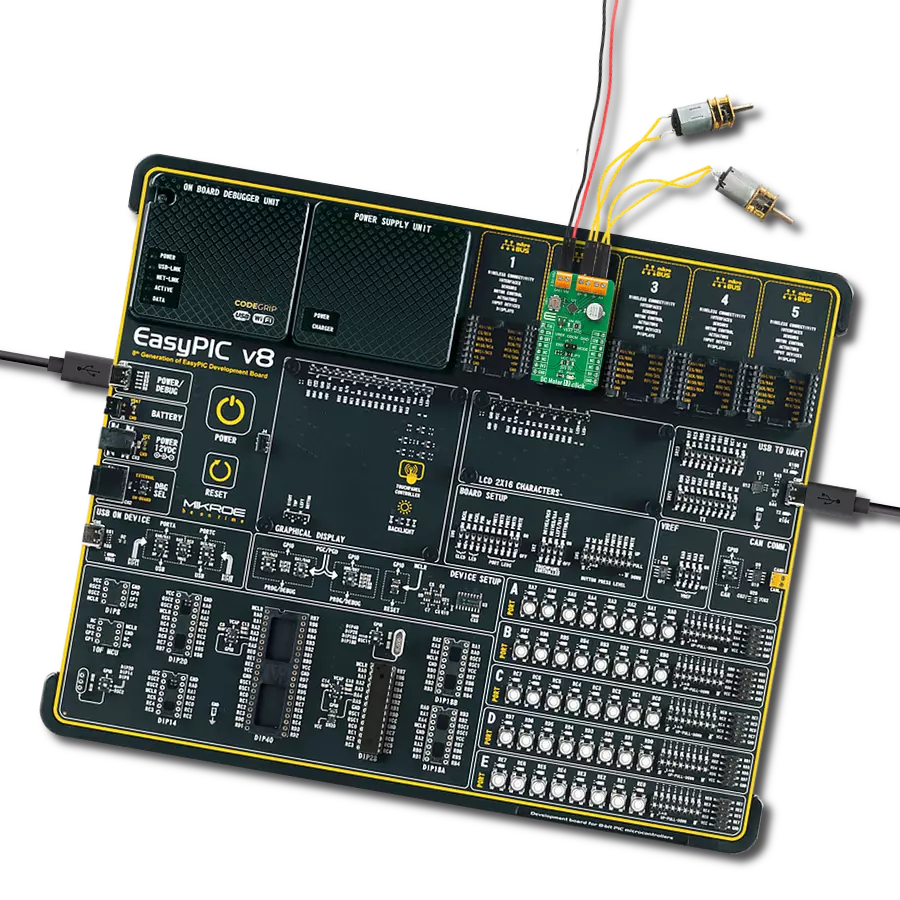Compact and adaptable solution for managing motor-driven functions in various applications
A
A
Hardware Overview
How does it work?
H-Bridge 15 Click is based on the DRV8834, a dual-bridge stepper or DC motor driver from Texas Instruments. The output driver block of each H-Bridge consists of N-channel power MOSFETs configured as an H-Bridge to drive the motor windings. Each H-Bridge includes circuitry to regulate or limit the winding current. There are two general control modes. The indexer logic with simple step/direction control and up to 1/32-step micro-stepping is one. The other is a phase/enable control that can drive external references for more than 1/32-step micro-stepping. The PCA9538, a low-voltage 8-bit I/O port from NXP, controls the logic states of the motor driver inputs. By setting the CONFIG input pin of the motor driver to a HIGH
state, you can select the indexer mode. Otherwise, you can select the phase/enable mode. Please note that you can drive DC motors only in phase/enable mode, while a stepper motor can be driven in any of these. The PCA9538 allows you to control the enable inputs of both bridges, micro-step modes, step inputs, direction, sleep mode, and more. It even takes the fault outputs of the motor driver. The voltage reference for both bridges is provided by the motor driver voltage reference output and two onboard potentiometers labeled VREF A and VREF B. Over those potentiometers, you can set the winding current for both bridges. The decay modes for both bridges are left for you to set over unpopulated jumper resistors. H-Bridge
15 Click uses a standard 2-wire I2C interface of the PCA9538 to allow the host MCU to control the motor driver inputs. It also notifies the host MCU if any fault condition occurs over the INT pin. The RST pin allows you to reset the PCA9538. The i2c address for this I/O port can be set over the I2C ADDR jumpers. There is also the ENA pin, which, in indexer mode, can turn all outputs on or off. This Click board™ can operate with either 3.3V or 5V logic voltage levels selected via the VCC SEL jumper. This way, both 3.3V and 5V capable MCUs can use the communication lines properly. Also, this Click board™ comes equipped with a library containing easy-to-use functions and an example code that can be used for further development.
Features overview
Development board
Clicker 4 for STM32F4 is a compact development board designed as a complete solution that you can use to quickly build your own gadgets with unique functionalities. Featuring an STM32F407VGT6 MCU, four mikroBUS™ sockets for Click boards™ connectivity, power management, and more, it represents a perfect solution for the rapid development of many different types of applications. At its core is an STM32F407VGT6 MCU, a powerful microcontroller by STMicroelectronics based on the high-performance
Arm® Cortex®-M4 32-bit processor core operating at up to 168 MHz frequency. It provides sufficient processing power for the most demanding tasks, allowing Clicker 4 to adapt to any specific application requirements. Besides two 1x20 pin headers, four improved mikroBUS™ sockets represent the most distinctive connectivity feature, allowing access to a huge base of Click boards™, growing on a daily basis. Each section of Clicker 4 is clearly marked, offering an intuitive and clean interface. This makes working with the
development board much simpler and, thus, faster. The usability of Clicker 4 doesn’t end with its ability to accelerate the prototyping and application development stages: it is designed as a complete solution that can be implemented directly into any project, with no additional hardware modifications required. Four mounting holes [4.2mm/0.165”] at all four corners allow simple installation by using mounting screws.
Microcontroller Overview
MCU Card / MCU
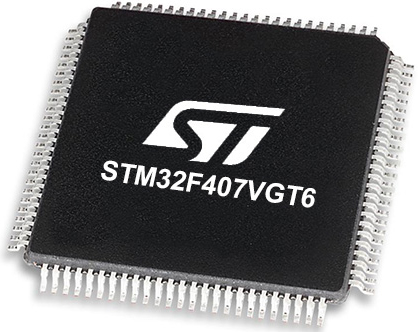
Architecture
ARM Cortex-M4
MCU Memory (KB)
10
Silicon Vendor
STMicroelectronics
Pin count
100
RAM (Bytes)
100
You complete me!
Accessories
DC Gear Motor - 430RPM (3-6V) represents an all-in-one combination of a motor and gearbox, where the addition of gear leads to a reduction of motor speed while increasing the torque output. This gear motor has a spur gearbox, making it a highly reliable solution for applications with lower torque and speed requirements. The most critical parameters for gear motors are speed, torque, and efficiency, which are, in this case, 520RPM with no load and 430RPM at maximum efficiency, alongside a current of 60mA and a torque of 50g.cm. Rated for a 3-6V operational voltage range and clockwise/counterclockwise rotation direction, this motor represents an excellent solution for many functions initially performed by brushed DC motors in robotics, medical equipment, electric door locks, and much more.
The 28BYJ-48 is an adaptable 5VDC stepper motor with a compact design, ideal for various applications. It features four phases, a speed variation ratio of 1/64, and a stride angle of 5.625°/64 steps, allowing precise control. The motor operates at a frequency of 100Hz and has a DC resistance of 50Ω ±7% at 25°C. It boasts an idle in-traction frequency greater than 600Hz and an idle out-traction frequency exceeding 1000Hz, ensuring reliability in different scenarios. With a self-positioning torque and in-traction torque both exceeding 34.3mN.m at 120Hz, the 28BYJ-48 offers robust performance. Its friction torque ranges from 600 to 1200 gf.cm, while the pull-in torque is 300 gf.cm. This motor makes a reliable and efficient choice for your stepper motor needs.
Used MCU Pins
mikroBUS™ mapper
Take a closer look
Click board™ Schematic

Step by step
Project assembly
Track your results in real time
Application Output
1. Application Output - In Debug mode, the 'Application Output' window enables real-time data monitoring, offering direct insight into execution results. Ensure proper data display by configuring the environment correctly using the provided tutorial.

2. UART Terminal - Use the UART Terminal to monitor data transmission via a USB to UART converter, allowing direct communication between the Click board™ and your development system. Configure the baud rate and other serial settings according to your project's requirements to ensure proper functionality. For step-by-step setup instructions, refer to the provided tutorial.

3. Plot Output - The Plot feature offers a powerful way to visualize real-time sensor data, enabling trend analysis, debugging, and comparison of multiple data points. To set it up correctly, follow the provided tutorial, which includes a step-by-step example of using the Plot feature to display Click board™ readings. To use the Plot feature in your code, use the function: plot(*insert_graph_name*, variable_name);. This is a general format, and it is up to the user to replace 'insert_graph_name' with the actual graph name and 'variable_name' with the parameter to be displayed.

Software Support
Library Description
This library contains API for H-Bridge 15 Click driver.
Key functions:
hbridge15_set_pins- H-Bridge 15 set pins function.hbridge15_set_sleep- H-Bridge 15 set sleep function.hbridge15_set_out_state- H-Bridge 15 set output function.
Open Source
Code example
The complete application code and a ready-to-use project are available through the NECTO Studio Package Manager for direct installation in the NECTO Studio. The application code can also be found on the MIKROE GitHub account.
/*!
* @file main.c
* @brief H-Bridge 15 Click example
*
* # Description
* This example demonstrates the use of the H-Bridge 15 Click board by
* driving the motor in both directions with braking and freewheeling.
*
* The demo application is composed of two sections :
*
* ## Application Init
* Initializes the driver and performs the Click default configuration.
*
* ## Application Task
* This example is driving a motor in both directions with
* motor braking and freewheeling in between.
*
* @author Stefan Ilic
*
*/
#include "board.h"
#include "log.h"
#include "hbridge15.h"
static hbridge15_t hbridge15;
static log_t logger;
void application_init ( void )
{
log_cfg_t log_cfg; /**< Logger config object. */
hbridge15_cfg_t hbridge15_cfg; /**< Click config object. */
/**
* Logger initialization.
* Default baud rate: 115200
* Default log level: LOG_LEVEL_DEBUG
* @note If USB_UART_RX and USB_UART_TX
* are defined as HAL_PIN_NC, you will
* need to define them manually for log to work.
* See @b LOG_MAP_USB_UART macro definition for detailed explanation.
*/
LOG_MAP_USB_UART( log_cfg );
log_init( &logger, &log_cfg );
log_info( &logger, " Application Init " );
// Click initialization.
hbridge15_cfg_setup( &hbridge15_cfg );
HBRIDGE15_MAP_MIKROBUS( hbridge15_cfg, MIKROBUS_1 );
if ( I2C_MASTER_ERROR == hbridge15_init( &hbridge15, &hbridge15_cfg ) )
{
log_error( &logger, " Communication init." );
for ( ; ; );
}
if ( HBRIDGE15_ERROR == hbridge15_default_cfg ( &hbridge15 ) )
{
log_error( &logger, " Default configuration." );
for ( ; ; );
}
log_info( &logger, " Application Task " );
}
void application_task ( void )
{
log_printf( &logger, " Motor in forward mode. \r\n" );
hbridge15_set_out_state( &hbridge15, HBRIDGE15_DRIVE_MOTOR_FORWARD );
Delay_ms ( 1000 );
Delay_ms ( 1000 );
Delay_ms ( 1000 );
Delay_ms ( 1000 );
Delay_ms ( 1000 );
log_printf( &logger, " Motor brake is on \r\n" );
hbridge15_set_out_state( &hbridge15, HBRIDGE15_DRIVE_MOTOR_BRAKE );
Delay_ms ( 1000 );
Delay_ms ( 1000 );
log_printf( &logger, " Motor in reverse mode. \r\n" );
hbridge15_set_out_state( &hbridge15, HBRIDGE15_DRIVE_MOTOR_REVERSE );
Delay_ms ( 1000 );
Delay_ms ( 1000 );
Delay_ms ( 1000 );
Delay_ms ( 1000 );
Delay_ms ( 1000 );
log_printf( &logger, " Motor is coasting \r\n" );
hbridge15_set_out_state( &hbridge15, HBRIDGE15_DRIVE_MOTOR_FREEWHEEL );
Delay_ms ( 1000 );
Delay_ms ( 1000 );
}
int main ( void )
{
/* Do not remove this line or clock might not be set correctly. */
#ifdef PREINIT_SUPPORTED
preinit();
#endif
application_init( );
for ( ; ; )
{
application_task( );
}
return 0;
}
// ------------------------------------------------------------------------ END
Additional Support
Resources
Category:Brushed





















